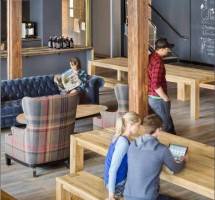October 13, 2016
London needs to adapt to the changing world of work, claims think tank 0
 Think Tank New London Architecture (NLA) which creates a forum for debate on the built environment, has launched its findings and recommendations from its landmark WRK / LDN Insight study on work and workplaces in London. NLA calls on central government, the Mayor of London and other stakeholders in the capital to act to maintain the capital’s position as a preeminent commercial centre. The report claims that, as the digital economy continues to expand, new suppliers of workspace are rapidly emerging – from co-working providers to ‘fab labs’, makerspaces, incubators and innovation centres. The insight study concludes that the affordable business space that currently supports these industries is at risk. London needs new innovative mixed-use models of city planning to support these changes and adapt to the changing world of work.
Think Tank New London Architecture (NLA) which creates a forum for debate on the built environment, has launched its findings and recommendations from its landmark WRK / LDN Insight study on work and workplaces in London. NLA calls on central government, the Mayor of London and other stakeholders in the capital to act to maintain the capital’s position as a preeminent commercial centre. The report claims that, as the digital economy continues to expand, new suppliers of workspace are rapidly emerging – from co-working providers to ‘fab labs’, makerspaces, incubators and innovation centres. The insight study concludes that the affordable business space that currently supports these industries is at risk. London needs new innovative mixed-use models of city planning to support these changes and adapt to the changing world of work.









 Businesses are ready to embrace the new era of robot workers, automation and artificial intelligence, according to a new report.
Businesses are ready to embrace the new era of robot workers, automation and artificial intelligence, according to a new report. 
 Just one in three IT decision makers believe advances such as cloud-based solutions, big data and wearable tech will be available in their industry within the next 12 months, according to a new study from Capita. Although the report – Trends vs Technologies – has yet to be published, the firm has released some of its findings. Based on a survey of IT professionals in the insurance, finance, legal services and manufacturing sectors, the study analyses nine key organisational trends and the implementation of related technology. The report claims that while many decision makers describe a tech trend as being relevant to their industry, several barriers to implementation mean solutions are not yet ready and in many cases might be lagging behind consumer take-up of the new technology. The trends named in the report are Big Data, Digital Workplace, Artificial Intelligence, Internet of Things, Wearable Tech, Robotics, Cloud Based Solutions, 3D Printers and Virtual Reality.
Just one in three IT decision makers believe advances such as cloud-based solutions, big data and wearable tech will be available in their industry within the next 12 months, according to a new study from Capita. Although the report – Trends vs Technologies – has yet to be published, the firm has released some of its findings. Based on a survey of IT professionals in the insurance, finance, legal services and manufacturing sectors, the study analyses nine key organisational trends and the implementation of related technology. The report claims that while many decision makers describe a tech trend as being relevant to their industry, several barriers to implementation mean solutions are not yet ready and in many cases might be lagging behind consumer take-up of the new technology. The trends named in the report are Big Data, Digital Workplace, Artificial Intelligence, Internet of Things, Wearable Tech, Robotics, Cloud Based Solutions, 3D Printers and Virtual Reality.




















April 11, 2016
What our enduring love of wooden office furniture tells us about how we work
by Paul Goodchild • Comment, Furniture, Workplace design
(more…)